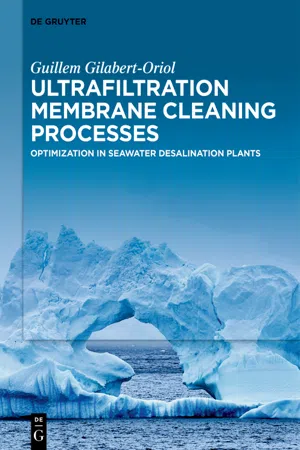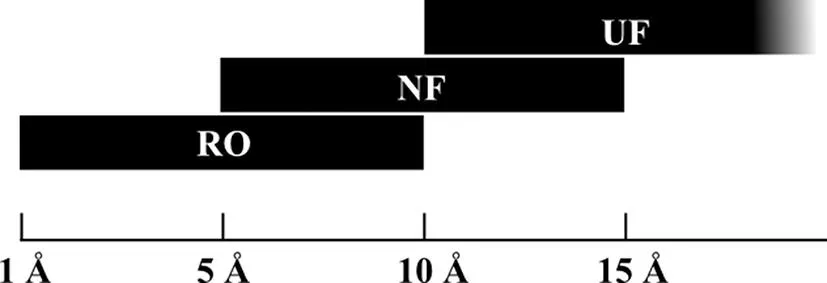
eBook - ePub
Ultrafiltration Membrane Cleaning Processes
Optimization in Seawater Desalination Plants
- 124 pages
- English
- ePUB (mobile friendly)
- Available on iOS & Android
eBook - ePub
Ultrafiltration Membrane Cleaning Processes
Optimization in Seawater Desalination Plants
About this book
This book covers the ultrafiltration membranes, specifically focusing on the elements that are produced using PVDF technology and out-side-in configuration. It specifically targets ultrafiltration technology as a pretreatment of seawater reverse osmosis desalination process. However, what is described in the book can be leveraged in other ultrafiltration membrane types. It explains how to significantly improve the efficiency of the process.
Frequently asked questions
Yes, you can cancel anytime from the Subscription tab in your account settings on the Perlego website. Your subscription will stay active until the end of your current billing period. Learn how to cancel your subscription.
No, books cannot be downloaded as external files, such as PDFs, for use outside of Perlego. However, you can download books within the Perlego app for offline reading on mobile or tablet. Learn more here.
Perlego offers two plans: Essential and Complete
- Essential is ideal for learners and professionals who enjoy exploring a wide range of subjects. Access the Essential Library with 800,000+ trusted titles and best-sellers across business, personal growth, and the humanities. Includes unlimited reading time and Standard Read Aloud voice.
- Complete: Perfect for advanced learners and researchers needing full, unrestricted access. Unlock 1.4M+ books across hundreds of subjects, including academic and specialized titles. The Complete Plan also includes advanced features like Premium Read Aloud and Research Assistant.
We are an online textbook subscription service, where you can get access to an entire online library for less than the price of a single book per month. With over 1 million books across 1000+ topics, we’ve got you covered! Learn more here.
Look out for the read-aloud symbol on your next book to see if you can listen to it. The read-aloud tool reads text aloud for you, highlighting the text as it is being read. You can pause it, speed it up and slow it down. Learn more here.
Yes! You can use the Perlego app on both iOS or Android devices to read anytime, anywhere — even offline. Perfect for commutes or when you’re on the go.
Please note we cannot support devices running on iOS 13 and Android 7 or earlier. Learn more about using the app.
Please note we cannot support devices running on iOS 13 and Android 7 or earlier. Learn more about using the app.
Yes, you can access Ultrafiltration Membrane Cleaning Processes by Guillem Gilabert-Oriol in PDF and/or ePUB format, as well as other popular books in Physical Sciences & Environmental Science. We have over one million books available in our catalogue for you to explore.
Information
1 Introduction
The popularity of membranes is increasing drastically in a broad range of industrial processes, thanks to its ability to control the permeation rate of species through the membrane. This allows the design of different separation processes, where the goal is to allow one component of a mixture to permeate freely through the membrane, while the other elements have difficulties to permeate. This is achieved through different driving forces which drive each different mass transfer across the membrane. These are represented by any combination of a concentration, a pressure, a temperature or an electric potential gradient.
One of the key aspects of membranes is to effectively control the membrane fouling, which decreases the permeability of the membrane. If fouling is not properly controlled, the membrane can irreversibly lose flow.
Ultrafiltration, in particular, is a separation membrane technology based on particle size exclusion. This is achieved thanks to the different small micropores which act as a sieve and prevent the particles which are bigger than the pore diameters to flow freely through the membrane. The use of ultrafiltration as a pretreatment of the reverse osmosis in the seawater desalination application has gained special popularity in recent years. Ultrafiltration is a key factor in reducing fouling to the reverse osmosis. Among its key benefits against the conventional pretreatment are a lower footprint and a better filtrate water quality.
1.1 Membrane filtration
Membranes are classified according to their pore diameter. An overview of each membrane technology regarding its pore diameter is given in the next paragraph. In addition, Figure 1.1 provides a graphical scheme summary [1]. Figure 1.2 details the intersection region between both mass transport models [1]. The pore flow model is represented by ultrafiltration, and the solution diffusion model is represented by reverse osmosis. In the intermediate section, nanofiltration combines both models to describe its behavior. Finally, Table 1.1 illustrates some examples of typical species that are filtrated using one of the described membrane technologies, together with their typical size [1]. Therefore, using Figures 1.1 and 1.2, it is possible to assess which filtration technology will be more suitable to filtrate or concentrate one of the species shown in the table.

Figure 1.1: Membranes classified by their pore diameter.

Figure 1.2: Reverse osmosis, nanofiltration and ultrafiltration membranes classified by their pore diameter.
Table 1.1:Species with their size.
| Species | Size |
|---|---|
| H2O | 0.2 nm |
| Na+ | 0.37 nm |
| Sucrose | 1 nm |
| Hemoglobin | 7 nm |
| Influenza virus | 0.1 µm |
| Pseudomonas diminuta | 0.28 µm |
| Staphylococcus bacteria | 1 µm |
| Starch | 10 µm |
Reverse osmosis membranes have pore diameters that range from 0.1 to 1 nm [1]. These pores have the particularity that they are so small that discrete pores do not exist. Instead, the pores are formed through unstable spaces between polymer chains, which are created and faded as a result of their molecular thermal motion. These fluctuating pores represent the diffusion of species throughout the dense membranes. In contraposition, the bigger and more stable pores observed in the ultrafiltration porous membranes represent the mass flux through convection described by the pore flow model. The solution diffusion model, which is not covered in this book, makes two assumptions. The first is that the solvents dissolve inside the membrane, and thereafter they diffuse through the dense film according to the present concentration gradient. In the reverse osmosis, separation occurs because of the different solubility and mobility of each species throughout the membrane.
Nanofiltration membranes have pore diameters that range from 0.5 to 1.5 nm [1]. These pores have the particularity of being between truly microporus membranes and clearly dense films. Therefore, mass transfer through nanofiltration membranes is described using both pore flow and solution diffusion models. This happens because if membrane polymer chains are very stiff, the molecular motion of the polymer is...
Table of contents
- Title Page
- Copyright
- Contents
- Abstract
- About the author
- Abbreviations
- 1 Introduction
- 2 Optimizing seawater operating protocols for pressurized ultrafiltration based on advanced cleaning research – backwash optimization I
- 3 Ultrafiltration advanced cleaning research and modeling applied to seawater – backwash optimization II
- 4 High-efficiency operation of pressurized ultrafiltration based on seawater advanced cleaning research – backwash optimization III
- 5 Backwashing using reverse osmosis brine in seawater desalination and its potential cost savings
- 6 Reverse osmosis chlorination risk and prevention approaches in ultrafiltration and reverse osmosis-integrated systems
- 7 Summary and outlook
- Index